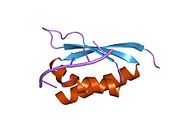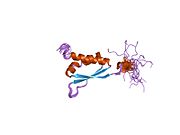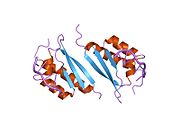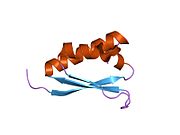HNRNPK
Heterogeneous nuclear ribonucleoprotein K (also protein K) is a protein that in humans is encoded by the HNRNPK gene.[5] It is found in the cell nucleus that binds to pre-messenger RNA (mRNA) as a component of heterogeneous ribonucleoprotein particles. The simian homolog is known as protein H16. Both proteins bind to single-stranded DNA as well as to RNA and can stimulate the activity of RNA polymerase II, the protein responsible for most gene transcription. The relative affinities of the proteins for DNA and RNA vary with solution conditions and are inversely correlated, so that conditions promoting strong DNA binding result in weak RNA binding.[6]
RNA binding protein domains in other proteins that are similar to the RNA binding domain of protein K are called K-homology or KH domains.
Protein K has been the subject of study related to colorectal cancer, in which an RNA editing event inducing the expression of an isoform containing a point mutation was found to be specific to cancerous cells.[7]
Function
This gene belongs to the subfamily of ubiquitously expressed heterogeneous nuclear ribonucleoproteins (hnRNPs). The hnRNPs are RNA-binding proteins, and they complex with heterogeneous nuclear RNA (hnRNA). These proteins are associated with pre-mRNAs in the nucleus and appear to influence pre-mRNA processing and other aspects of mRNA metabolism and transport. While all of the hnRNPs are present in the nucleus, some seem to shuttle between the nucleus and the cytoplasm.
The hnRNP proteins have distinct nucleic acid binding properties. The protein encoded by this gene is located in the nucleoplasm and has three repeats of KH domains that binds to RNAs. It is distinct among other hnRNP proteins in its binding preference; it binds tenaciously to poly(C). This protein is also thought to have a role during cell cycle progression. Multiple alternatively spliced transcript variants have been described for this gene, but only three variants have been fully described.[8]
Mutations in both copies of HNRNPK are embryonic lethal in mice. Mice with both copies of the gene knocked out die before the 14th day of embryonic development.[9]
Clinical significance
Okamoto syndrome
Mutations in HNRNPK cause Okamoto syndrome, also known as Au–Kline syndrome.[10]
Blood cancers
Deletions in the region encompassing HNRNPK have been found in the cells of acute myeloid leukemia in approximately 2% of cases. Additionally, a majority of mice who have had one of their HNRNPK genes artificially knocked out developed myeloid cancers, with a third developing lymphoid cancers and 4% developing hepatocellular carcinomas. The mice were also smaller, had less developed organs and had higher postnatal mortality (30%). The median lifespan of the mice that survived was less than 50% that of wild-type mice. Deficiencies in HNRNPK appear to specifically reduce the levels of the p42 isoform of CEBPA, which is a transcription factor involved in the differentiation of certain blood cells, as well as p21 (cyclin-dependent kinase inhibitor 1), which is involved in pausing cell development for DNA repair.[11]
HNRNPK overexpression also appears to contribute to cancers via a different mechanism involving translation rather than transcription.[11]
Interactions
HNRPK has been shown to interact with:
Human proteins containing a KH domain
AKAP1; ANKHD1; ANKRD17; ASCC1; BICC1; DDX43; DDX53; DPPA5; FMR1; FUBP1; FUBP3; FXR1; FXR2; HDLBP; HNRPK; IGF2BP1; IGF2BP2; IGF2BP3; KHDRBS1; KHDRBS2; KHDRBS3; KHSRP; KRR1; MEX3A; MEX3B; MEX3C; MEX3D; NOVA1; NOVA2; PCBP1; PCBP2; PCBP3; PCBP4; PNO1; PNPT1; QKI; SF1; TDRKH;
References
- ^ a b c GRCh38: Ensembl release 89: ENSG00000165119 – Ensembl, May 2017
- ^ a b c GRCm38: Ensembl release 89: ENSMUSG00000021546 – Ensembl, May 2017
- ^ "Human PubMed Reference:". National Center for Biotechnology Information, U.S. National Library of Medicine.
- ^ "Mouse PubMed Reference:". National Center for Biotechnology Information, U.S. National Library of Medicine.
- ^ Dejgaard K, Leffers H, Rasmussen HH, Madsen P, Kruse TA, Gesser B, et al. (February 1994). "Identification, molecular cloning, expression and chromosome mapping of a family of transformation upregulated hnRNP-K proteins derived by alternative splicing". Journal of Molecular Biology. 236 (1): 33–48. doi:10.1006/jmbi.1994.1116. PMID 8107114.
- ^ Gaillard C, Cabannes E, Strauss F (October 1994). "Identity of the RNA-binding protein K of hnRNP particles with protein H16, a sequence-specific single strand DNA-binding protein". Nucleic Acids Research. 22 (20): 4183–6. doi:10.1093/nar/22.20.4183. PMC 331915. PMID 7524036.
- ^ Klimek-Tomczak K, Mikula M, Dzwonek A, Paziewska A, Karczmarski J, Hennig E, et al. (February 2006). "Editing of hnRNP K protein mRNA in colorectal adenocarcinoma and surrounding mucosa". British Journal of Cancer. 94 (4): 586–92. doi:10.1038/sj.bjc.6602938. PMC 2361188. PMID 16404425.
- ^ "Entrez Gene: HNRPK heterogeneous nuclear ribonucleoprotein K".
- ^ Gallardo M, Lee HJ, Zhang X, Bueso-Ramos C, Pageon LR, McArthur M, et al. (October 2015). "hnRNP K Is a Haploinsufficient Tumor Suppressor that Regulates Proliferation and Differentiation Programs in Hematologic Malignancies". Cancer Cell. 28 (4): 486–499. doi:10.1016/j.ccell.2015.09.001. PMC 4652598. PMID 26412324.
- ^ Reference GH. "Au-Kline syndrome". Genetics Home Reference. Retrieved 2019-11-30.
- ^ a b Gallardo M, Lee HJ, Zhang X, Bueso-Ramos C, Pageon LR, McArthur M, et al. (October 2015). "hnRNP K Is a Haploinsufficient Tumor Suppressor that Regulates Proliferation and Differentiation Programs in Hematologic Malignancies". Cancer Cell. 28 (4): 486–499. doi:10.1016/j.ccell.2015.09.001. PMC 4652598. PMID 26412324.
- ^ Ostareck-Lederer A, Ostareck DH, Cans C, Neubauer G, Bomsztyk K, Superti-Furga G, Hentze MW (July 2002). "c-Src-mediated phosphorylation of hnRNP K drives translational activation of specifically silenced mRNAs". Molecular and Cellular Biology. 22 (13): 4535–43. doi:10.1128/mcb.22.13.4535-4543.2002. PMC 133888. PMID 12052863.
- ^ Chen HC, Lin WC, Tsay YG, Lee SC, Chang CJ (October 2002). "An RNA helicase, DDX1, interacting with poly(A) RNA and heterogeneous nuclear ribonucleoprotein K". The Journal of Biological Chemistry. 277 (43): 40403–9. doi:10.1074/jbc.M206981200. PMID 12183465.
- ^ a b c Kim JH, Hahm B, Kim YK, Choi M, Jang SK (May 2000). "Protein-protein interaction among hnRNPs shuttling between nucleus and cytoplasm". Journal of Molecular Biology. 298 (3): 395–405. doi:10.1006/jmbi.2000.3687. PMID 10772858.
- ^ Yang JP, Reddy TR, Truong KT, Suhasini M, Wong-Staal F (October 2002). "Functional interaction of Sam68 and heterogeneous nuclear ribonucleoprotein K". Oncogene. 21 (47): 7187–94. doi:10.1038/sj.onc.1205759. PMID 12370808. S2CID 26091319.
- ^ Côté J, Boisvert FM, Boulanger MC, Bedford MT, Richard S (January 2003). "Sam68 RNA binding protein is an in vivo substrate for protein arginine N-methyltransferase 1". Molecular Biology of the Cell. 14 (1): 274–87. doi:10.1091/mbc.E02-08-0484. PMC 140244. PMID 12529443.
- ^ Wada K, Inoue K, Hagiwara M (August 2002). "Identification of methylated proteins by protein arginine N-methyltransferase 1, PRMT1, with a new expression cloning strategy". Biochimica et Biophysica Acta (BBA) - Molecular Cell Research. 1591 (1–3): 1–10. doi:10.1016/s0167-4889(02)00202-1. PMID 12183049.
Further reading
- Bomsztyk K, Denisenko O, Ostrowski J (June 2004). "hnRNP K: one protein multiple processes". BioEssays. 26 (6): 629–38. doi:10.1002/bies.20048. PMID 15170860. S2CID 22108788.
- Matunis MJ, Michael WM, Dreyfuss G (January 1992). "Characterization and primary structure of the poly(C)-binding heterogeneous nuclear ribonucleoprotein complex K protein". Molecular and Cellular Biology. 12 (1): 164–71. doi:10.1128/MCB.12.1.164. PMC 364080. PMID 1729596.
- Weng Z, Thomas SM, Rickles RJ, Taylor JA, Brauer AW, Seidel-Dugan C, et al. (July 1994). "Identification of Src, Fyn, and Lyn SH3-binding proteins: implications for a function of SH3 domains". Molecular and Cellular Biology. 14 (7): 4509–21. doi:10.1128/MCB.14.7.4509. PMC 358823. PMID 7516469.
- Bustelo XR, Suen KL, Michael WM, Dreyfuss G, Barbacid M (March 1995). "Association of the vav proto-oncogene product with poly(rC)-specific RNA-binding proteins". Molecular and Cellular Biology. 15 (3): 1324–32. doi:10.1128/MCB.15.3.1324. PMC 230356. PMID 7862126.
- Hobert O, Jallal B, Schlessinger J, Ullrich A (August 1994). "Novel signaling pathway suggested by SH3 domain-mediated p95vav/heterogeneous ribonucleoprotein K interaction". The Journal of Biological Chemistry. 269 (32): 20225–8. doi:10.1016/S0021-9258(17)31979-8. PMID 8051112.
- Aasheim HC, Loukianova T, Deggerdal A, Smeland EB (March 1994). "Tissue specific expression and cDNA structure of a human transcript encoding a nucleic acid binding [oligo(dC)] protein related to the pre-mRNA binding protein K". Nucleic Acids Research. 22 (6): 959–64. doi:10.1093/nar/22.6.959. PMC 307915. PMID 8152927.
- Buckanovich RJ, Posner JB, Darnell RB (October 1993). "Nova, the paraneoplastic Ri antigen, is homologous to an RNA-binding protein and is specifically expressed in the developing motor system". Neuron. 11 (4): 657–72. doi:10.1016/0896-6273(93)90077-5. PMID 8398153. S2CID 22554933.
- Michelotti EF, Michelotti GA, Aronsohn AI, Levens D (May 1996). "Heterogeneous nuclear ribonucleoprotein K is a transcription factor". Molecular and Cellular Biology. 16 (5): 2350–60. doi:10.1128/MCB.16.5.2350. PMC 231223. PMID 8628302.
- Bunnell SC, Henry PA, Kolluri R, Kirchhausen T, Rickles RJ, Berg LJ (October 1996). "Identification of Itk/Tsk Src homology 3 domain ligands". The Journal of Biological Chemistry. 271 (41): 25646–56. doi:10.1074/jbc.271.41.25646. PMID 8810341.
- Tommerup N, Leffers H (March 1996). "Assignment of human KH-box-containing genes by in situ hybridization: HNRNPK maps to 9q21.32-q21.33, PCBP1 to 2p12-p13, and PCBP2 to 12q13.12-q13.13, distal to FRA12A". Genomics. 32 (2): 297–8. doi:10.1006/geno.1996.0121. PMID 8833161.
- Kai N, Mishina M, Yagi T (June 1997). "Molecular cloning of Fyn-associated molecules in the mouse central nervous system". Journal of Neuroscience Research. 48 (5): 407–24. doi:10.1002/(SICI)1097-4547(19970601)48:5<407::AID-JNR3>3.0.CO;2-I. PMID 9185665. S2CID 33016242.
- Miau LH, Chang CJ, Shen BJ, Tsai WH, Lee SC (April 1998). "Identification of heterogeneous nuclear ribonucleoprotein K (hnRNP K) as a repressor of C/EBPbeta-mediated gene activation". The Journal of Biological Chemistry. 273 (17): 10784–91. doi:10.1074/jbc.273.17.10784. PMID 9553145.
- Hsieh TY, Matsumoto M, Chou HC, Schneider R, Hwang SB, Lee AS, Lai MM (July 1998). "Hepatitis C virus core protein interacts with heterogeneous nuclear ribonucleoprotein K". The Journal of Biological Chemistry. 273 (28): 17651–9. doi:10.1074/jbc.273.28.17651. PMID 9651361.
- Schullery DS, Ostrowski J, Denisenko ON, Stempka L, Shnyreva M, Suzuki H, et al. (May 1999). "Regulated interaction of protein kinase Cdelta with the heterogeneous nuclear ribonucleoprotein K protein". The Journal of Biological Chemistry. 274 (21): 15101–9. doi:10.1074/jbc.274.21.15101. PMID 10329716.
- Baber JL, Libutti D, Levens D, Tjandra N (June 1999). "High precision solution structure of the C-terminal KH domain of heterogeneous nuclear ribonucleoprotein K, a c-myc transcription factor". Journal of Molecular Biology. 289 (4): 949–62. doi:10.1006/jmbi.1999.2818. PMID 10369774. S2CID 6846849.
- Wadd S, Bryant H, Filhol O, Scott JE, Hsieh TY, Everett RD, Clements JB (October 1999). "The multifunctional herpes simplex virus IE63 protein interacts with heterogeneous ribonucleoprotein K and with casein kinase 2". The Journal of Biological Chemistry. 274 (41): 28991–8. doi:10.1074/jbc.274.41.28991. PMID 10506147.
- Venables JP, Elliott DJ, Makarova OV, Makarov EM, Cooke HJ, Eperon IC (March 2000). "RBMY, a probable human spermatogenesis factor, and other hnRNP G proteins interact with Tra2beta and affect splicing". Human Molecular Genetics. 9 (5): 685–94. doi:10.1093/hmg/9.5.685. PMID 10749975.
- Kim JH, Hahm B, Kim YK, Choi M, Jang SK (May 2000). "Protein-protein interaction among hnRNPs shuttling between nucleus and cytoplasm". Journal of Molecular Biology. 298 (3): 395–405. doi:10.1006/jmbi.2000.3687. PMID 10772858.
- Shnyreva M, Schullery DS, Suzuki H, Higaki Y, Bomsztyk K (May 2000). "Interaction of two multifunctional proteins. Heterogeneous nuclear ribonucleoprotein K and Y-box-binding protein". The Journal of Biological Chemistry. 275 (20): 15498–503. doi:10.1074/jbc.275.20.15498. PMID 10809782.











